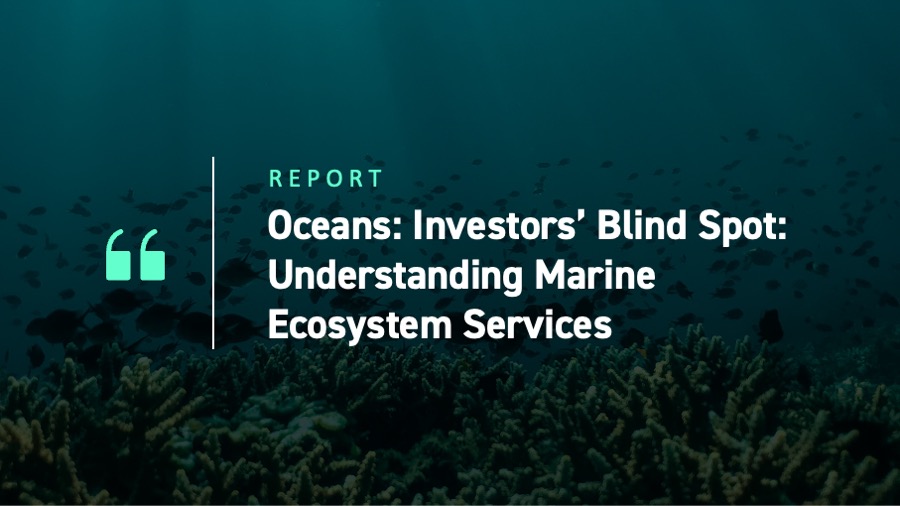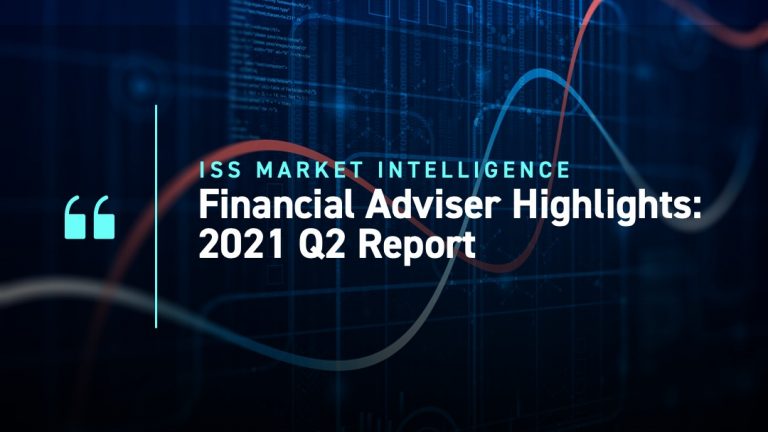Ecosystem Services Explained: Marine Ecosystems
Oceans are central to the nature conversation yet are less understood or talked about than other aspects of natural capital. To put in perspective oceans’ significance, they cover “three-quarters of the Earth’s surface, contain 97 percent of the Earth’s water, and represent 99 percent of the living space on the planet by volume.” Marine life also offers a massive source of biodiversity, with over 250,000 known species and many more yet to be identified.
Oceans also provide a broad range of ecosystem services. Ecosystem services are “the direct and indirect contributions of ecosystems to human well-being, and [they] have an impact on our survival and quality of life.” Understanding ecosystem services can help investors 1) to assess the economic value of natural assets and 2) to identify a company’s unique nature-related risks and dependencies in its direct operations and across its value chains.
There are four different types of ecosystem services. Oceans—and marine ecosystems specifically—contribute to all of them in a meaningful way. Those services are summarized in Table 1, which uses the example of coral reefs to illustrate the ecosystem services concepts.
Table 1: Ecosystem Services: Coral Reefs Example
| ECOSYSTEM SERVICE TYPE | DESCRIPTION OF THE ECOSYSTEM SERVICE | EXAMPLES OF CONTRIBUTIONS BY A MARINE ECOSYSTEM: CORAL REEFS |
| Regulation | Certain ecosystem processes moderate natural phenomena. Regulating services include pollination, decomposition, water purification, erosion and flood control, carbon storage, and climate regulation. | The world’s largest coral reefs structures serve as “seawalls against storms, hurricanes, and sea level rise by protecting coasts from waves and surge.” A report shows the “total value of coastal protection [globally] provided by reefs is estimated at over $4 billion in averted damages during usual storms.” That number may rise as storm intensity increases. |
| Supporting | Ecosystems could not be sustained without the consistency of underlying natural processes, such as photosynthesis, nutrient cycling, the creation of soils, and the water cycle. These processes allow the Earth to sustain basic life forms. | Coral reefs support the habitats for many marine species. Scientists note that “the number of species living per unit area on coral reefs is one of the highest on the planet, with biodiversity that rivals rainforests.” |
| Provisioning | A provisioning service is a benefit to people that can be extracted from nature: food, drinking water, timber, wood fuel, natural gas, oils, and plants. | Coral reefs are called the “medicine chests of the 21st century.” Coral reefs have been used in research for treatments for cancer, HIV, and other conditions. |
| Cultural | A cultural service is a non-material benefit that contributes to the development and cultural advancement of people, including how ecosystems play a role in local, national, and global cultures; creativity; and recreation. | According to a recent report, “At least 94 countries and territories benefit from reef tourism. In 23 of these, reef tourism accounts for more than 15 percent of gross domestic product.” |
What Does This All Mean for Investors?
Most institutional investors are looking to expand their understanding of their portfolio companies’ nature-related impact and dependencies. Oceans appear to be the least acknowledged type of natural capital. A 2022 WWF survey of 42 asset managers—with various structures and strategies—found that while 76% of their survey respondents have publicly acknowledged that biodiversity or nature-related impacts “may pose risks to companies’ activities,” only 27% referenced marine life or oceans. What is more telling is that only one manager, in the whole sample, had disclosed an ocean sustainability policy.
Similarly, SDG 14: Life Below Water, which is intended to protect the oceans and ensure the sustainable use of seas and marine resources, remains the least funded of all the SDGs. Estimates show that achieving SDG 14 by 2030 requires $175 billion of investments per year, yet “between 2015 and 2019, just below $10 billion in total was invested.”
Understanding the many ecosystem services that oceans provide can help investors develop a targeted impact strategy aligned with SDG 14 to intentionally protect oceans and contribute to the restoration of different marine ecosystems. For those investors that are focused mainly on risk-adjusted returns, taking into consideration certain industries and particular companies’ dependencies on marine resources—using both modeled ecosystem services data or reported data—can help identify leaders and laggards on oceans-related issues such as seafood production, marine transportation, plastic pollution, and wastewater management, among others.
Explore ISS ESG solutions mentioned in this report:
- Identify ESG risks and seize investment opportunities with the ISS ESG Corporate Rating.
- ISS ESG’s Biodiversity Impact Assessment Tool helps investors assess the impact of companies’ business and supply chain activities on biodiversity.
By: Mirtha Kastrapeli, Global Head of Natural Capital, ISS ESG




